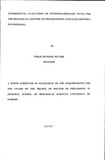| dc.description.abstract | The leishmaniases are some of the WHO's neglected tropical diseases which pose threat
to human life in both the New and Old World. They are mostly transmitted through the
bite of infected sand flies. The disease affects the poor from the third world. Disease
control through chemotherapy is logistically difficult, toxic, expensive and out of reach
for many. Entomopathogenic fungi (EPF) hold great potential as alternative vector
control. These fungi infect the host through the cuticle. They are friendlier to non-target
organisms than synthetic chemical insecticides. Although EPF are widely used to control
agricultural pests, few attempts have been made to develop them as biocontrol agents of
disease vectors like phlebotomine sand flies. The study had two phases: laboratory and
field based studies. Isolates were cultured on Sabourand dextrose agar (SDA) in Petri
dishes and incubated at room temperature (22-28 DC).In the laboratory, sand flies were
exposed to 0.3 g of dry conidia evenly spread on a cotton velvet cloth covering the inner
side of a cylindrical plastic tube (95x48 mm diam). Control flies were not exposed to any
conidia. Mortality was recorded daily until all the sand flies died. The study tested 16
isolates of Metarhizium anisopliae and 3 of Beauveria bassiana to adult sand fly spp of
Phlebotomus duboscqi in the laboratory. All the fungal isolates were pathogenic to the
test-insect, causing mortality of between 76.8 and 100%. The (LTso) and (LT90) ranged
from 3.0-7.8 days and from 5.3-16.2 days, respectively. One of the most virulent isolates
of M anisopliae was tested in the field at Rabai in Marigat Division, Baringo County.
Dry conidia of the fungi (2.0 x 1014
) were introduced into ten termite mounds through the
shafts using a modified foot pump. Preliminary results indicate that application of the
fungus in termite mounds resulted in three to ten-fold reduction in the population of sand
flies after 8 weeks. Two weeks after introduction of the conidia, the longevity of sand
flies collected from treated termite mounds was shorter than those in the control mounds.
Sand flies from the treated mounds died within 9 days whereas over 90% of sand flies
collected from the untreated control termite mounds survived for more than 21 days.
These results clearly demonstrate the potential of EPF as a biological control of
phlebotomine sand flies. Further studies to determine the best methods for delivery and
application in the diverse ecological settings of various leishmaniasis vectors are
therefore recommended. | en |

